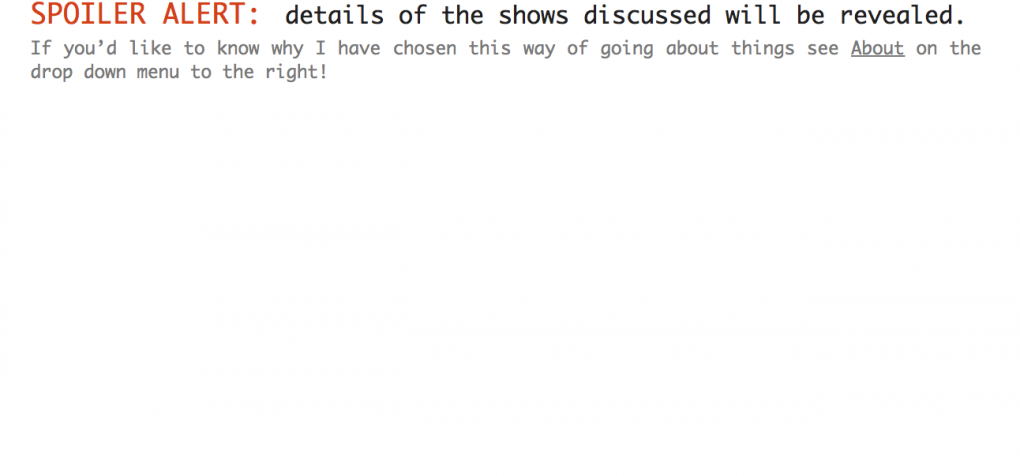
Lazarus at The King’s Cross Theatre
Written by Enda Walsh and David Bowie inspired by The Man Who Fell to Earth by Walter Trevis
Directed by Ivo Van Hove with design by Jan Versweyveld
Main Cast: Michael C. Hall, Thomas Jerome Newton; Sophia Anne Caruso, Girl; Amy Lennox, Elly; Michael Esper, Valentine; Richard Hansell, Zach.
___
So I Saw… Lazarus
Having played Thomas Jerome Newton (the alien who crash lands to earth in Nicolas Roeg’s 1976 cult-classic film The Man Who Fell to Earth) Bowie commented on how he ‘just threw [his] real self into that movie’[1] – going so far as to say that ‘what you see there is David Bowie’[2]. It’s funny (and a characteristically Bowie-esque contradiction) that whilst he claimed the presence of his ‘real self’ in his performance of Newton he was simultaneously generating a new persona: playing a part. Having seen Bowie’s posthumous musical, written jointly with Enda Walsh, I am left wondering if he would say of Lazarus that ‘what you see there is David Bowie’. I even question whether it’s appropriate to speculate about Bowie’s potentially intending, in this play/musical, to survive beyond death through his art – no matter how much Bowie fans (like myself) might like to. This seems contradictory for a show that goes by the name of Lazarus – an apparent allusion to the Biblical Lazarus, whom Jesus ‘raised from the dead’[3] – but hear me out.
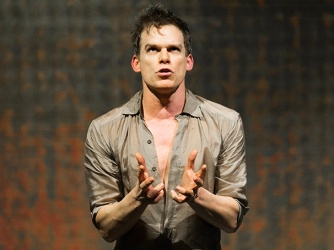 Lazarus starts with an old face: Thomas Jerome Newton. He is still stranded on earth (after his first attempt at building a rocket – seen in Roeg’s film) and we find him in his beige apartment, furnished sparsely: a fridge and record player against the righthand wall, and a bed on the opposite. As we quickly discover, Mary Lou (Newton’s lover in Roeg’s film) is no longer around. Nor is the dream that somehow he might return to his family on his home planet:
Lazarus starts with an old face: Thomas Jerome Newton. He is still stranded on earth (after his first attempt at building a rocket – seen in Roeg’s film) and we find him in his beige apartment, furnished sparsely: a fridge and record player against the righthand wall, and a bed on the opposite. As we quickly discover, Mary Lou (Newton’s lover in Roeg’s film) is no longer around. Nor is the dream that somehow he might return to his family on his home planet:
‘There’s nothing left of the past. It left. This is it now.’
Alone, he spends his days in the same way – as he informs us in a monotone:
‘I watch television and drink gin.’
and, occasionally
‘I walk around and try to locate the Twinkies.’
Newton is a broken man, wandering around his apartment – just as brokenly as the record player plays Ricky Nelson’s ‘Hello Mary Lou (Goodbye Heart)’ to open the show. By contrast Michael C. Hall’s performance as Newton is strong. His previous role as the main protagonist Dexter in the eponymous T.V. series explored similar themes as Lazarus (Dexter, orphaned age three when his mother was murdered by a madman with a chainsaw, has psychopathic tendencies and kills ‘constructively’, attacking heinous criminals, like murderers and rapists, who have escaped the justice system) but it gave Hall no opportunity to demonstrate his amazing voice – which, apart from being brilliant in its own right, channels intonations that are hauntingly reminiscent of Bowie.
Newton is also a trapped man:
‘I am a dying man who cannot die’.
Emotionally he is dying, but physically he can’t die (he’s not human) – so he dreams of escape. The first song he sings (‘Lazarus’ from Bowie’s last album, Blackstar) seems to express this with its aching saxophone, shallow beat and bitter dreaming refrain:
‘You know I’ll be free
Just like that bluebird
Ain’t that just like me.’
But he’s not only dreaming of escape; for in his gin-soaked state he sees things – he sees people. These figures materialise from behind a huge video screen standing in the centre of the stage; an action that is often so seamlessly performed that it appears as though they are emerging from the screen itself – as if it’s a sort of physical metaphor for Newton’s mind. This is firstly implied by the images of Mary Lou that dance across it, and because the strange celestial Girl (who claims she is there to ‘help’ Newton) – dismissed as
are emerging from the screen itself – as if it’s a sort of physical metaphor for Newton’s mind. This is firstly implied by the images of Mary Lou that dance across it, and because the strange celestial Girl (who claims she is there to ‘help’ Newton) – dismissed as
‘just another dream, a delusion, a chemical belch in my head!’
by Newton – emerges from it. Sophia Anne Caruso’s voice is as strong as Hall’s (despite the fact that she’s only fifteen) – and compliments it well. Her pure and clear notes lifting his hauntingly Bowie-like twangs to heights that brilliantly reimagine some of Bowie’s best-loved songs; for example ‘Heroes’, that closes the show. Yet she holds her own in others, like ‘Life On Mars?’ and ‘This is Not America’, her voice taking on an eery (although pitch-perfect) wailing quality – full of mysterious emotion.
These imagined figures, like the Girl, commingle with those in Newton’s ‘real’ world, blurring the distinction between his ‘delusion’ and reality. For example, just as the screen introduces Newton’s dreamed figures it is equally imposed upon by the characters of Newton’s ‘real’ life. Elly, Newton’s home assistant is the most notable example of this. Frustrated with her life – that leaves her asking her husband
‘…when was the last time we had sex? In what area of my life have I ever been successful?’
– she stares at the silhouettes of a woman bent romantically towards a man (that looks very like Newton) on the screen as she sings Bowie’s ‘Changes’, strips down to her underwear and changes into a brightly coloured satin blouse (reminiscent of Bowie’s New  Romanticism) that once belonged to Mary Lou. She then returns to the figures on the screen and violently circles her hand around the couple – leaving a scribbly red line as if circling something she desperately wants in a catalogue. This is all indicative of the fact that the line between Newton’s mental world and reality is blurred – and increasingly so. Later she will dye her hair blue and continue to transform herself into the image of Mary Lou that intermittently dances on the screen; making it difficult to tell if it’s she who is imposing herself upon the extraordinary Newton to escape her un-extraordinary life, or whether he is imposing the image of Mary Lou onto her.
Romanticism) that once belonged to Mary Lou. She then returns to the figures on the screen and violently circles her hand around the couple – leaving a scribbly red line as if circling something she desperately wants in a catalogue. This is all indicative of the fact that the line between Newton’s mental world and reality is blurred – and increasingly so. Later she will dye her hair blue and continue to transform herself into the image of Mary Lou that intermittently dances on the screen; making it difficult to tell if it’s she who is imposing herself upon the extraordinary Newton to escape her un-extraordinary life, or whether he is imposing the image of Mary Lou onto her.
This is at times a little too confusing: fairly often we are simply left wondering what on earth is going on. This reaches its apogee when Elly, who is now indistinguishable from  Mary Lou, sits in front of the screen (with a picture of Mary Lou on it, dancing behind a crouching Newton) facing the Girl, who is herself dressed as Mary Lou as she attempts to put on a ‘play’ to help Newton
Mary Lou, sits in front of the screen (with a picture of Mary Lou on it, dancing behind a crouching Newton) facing the Girl, who is herself dressed as Mary Lou as she attempts to put on a ‘play’ to help Newton
‘…forget about her [Mary Lou…so that he] can start making something else’;
a play that employs the help of a chorus-like group of three teenage girls who hang about the stage and are neither clearly a part of the ‘real’ world nor Newton’s dream. Add to this mix Valentine, a knife wielding serial killer who is a self-confessed
‘hopeless romantic’,
an idealist who has
‘always thought there has to be something more beautiful than what we’ve been given down here’,
and who violently reacts to the fact that
‘beautiful things – like friendship and being in love – can turn sour’,
makes things even more challenging to interpret. Especially as, like the teenage girls, he seems to be both real and another of Newton’s delusions – in fact one of these girls hands him his knife.
It might be tempting to impose clarity on this show by reading it biographically; arguably Jan Versweyveld’s beautiful staging invites us to. Versweyveld projects images onto the stage, turning Newton’s apartment into a sort of video screen. He even plays these images 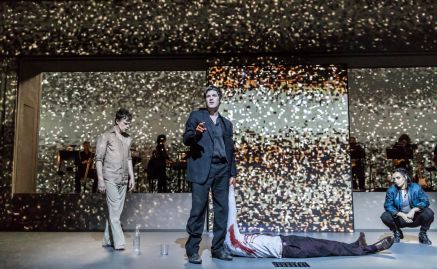 across the apartment’s large plain glass windows, that don’t look out onto the New York skyline but rather onto what seems to be a recording studio (where the live musicians really perform) – a starkly naturalistic contrast to the hallucinatory atmosphere of the front of stage (Newton’s flat). The screen stands between these windows (like the brain sits behind and between the eyes) suggesting that the dream world of Newton’s flat is a sort of inner reality; perhaps even an entirely mental one. This is apparently reinforced by the fact that often the characters who interact in the dream world of Newton’s flat press themselves up against these windows – as if trying to get out or to impress their feeling onto the musicians in the recording studio: as if to achieve escape through musical expression in the ‘real’ world. If we were to read Lazarus biographically, we might relate
across the apartment’s large plain glass windows, that don’t look out onto the New York skyline but rather onto what seems to be a recording studio (where the live musicians really perform) – a starkly naturalistic contrast to the hallucinatory atmosphere of the front of stage (Newton’s flat). The screen stands between these windows (like the brain sits behind and between the eyes) suggesting that the dream world of Newton’s flat is a sort of inner reality; perhaps even an entirely mental one. This is apparently reinforced by the fact that often the characters who interact in the dream world of Newton’s flat press themselves up against these windows – as if trying to get out or to impress their feeling onto the musicians in the recording studio: as if to achieve escape through musical expression in the ‘real’ world. If we were to read Lazarus biographically, we might relate 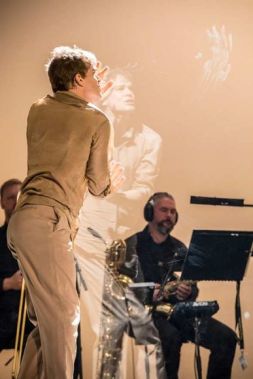 this to Bowie’s creative process.
this to Bowie’s creative process.
Further Versweyveld also clearly alludes to particular periods of Bowie’s work; most notably (and stunningly) to his famous Berlin-Phase, when he produced his ‘Berlin Trilogy’ (the albums ‘Low’ and Heroes in 1977, and in 1979 ‘Lodger’) whilst ‘on the edge of physical and mental collapse’[4] hooked on cocaine and drained by the constant attention given to him in LA. As Hall sings ‘Where Are We Now?’ (just as his voice has hauntingly Bowie-like tones, he also looks a little like Bowie, amplifying the biographic aspect of this moment), Versweyveld’s set is transformed into a montage of the Berlin in which Bowie found himself in the 70s (played on the screen) and that of the modern day (projected onto the back wall). It was in Berlin in the 70s that Bowie began to ‘remake himself as an ordinary man […] enjoy[ing] the Berliners’ disinterest in him’[5], managing to entertain again (as he put it) ‘a great feeling of release and healing’[6]. In light of Bowie’s death we might read this musical as a similar attempt to find a ‘feeling of release and healing’ in terms of his mortality; which is made all the more complex if your life has revolved around a series of personas, to such an extent that – as Geoffrey Marsh (who curated the V&As 2013 exhibition David Bowie Is, the ‘first international retrospective’[7] of Bowie’s work and aesthetic) puts it – ‘even as the artist David Bowie, he has assumed a character’[8], he has become a sort of conceptual figure of reinvention. Newton’s claim that he is a
‘dying man who cannot die’
has a certain ring with this notion of Bowie as a conceptual figure more than a man, and seems to ask whether it’s possible for someone like this to ever achieve peace – even in death.
Lazarus perhaps plays with this idea that Bowie has bequeathed to us his image: every one of us has our own Bowie – we each relate to his personas differently and impose upon them our own meanings, that in turn give us some personal ‘feeling of release and healing’. Whilst this means he sort of ‘lives on’ through us, this equally bars the man himself from having ownership over his life, and its end. As Newton says,
‘not being able to die is a joke. A fucking terrible joke.’
adding, as if conscious of his being watched,
‘apologies for the f-word’.
This is partly why we might question whether it’s appropriate to talk about this musical in regenerative terms: it seems wrong to see it somehow as Bowie resurrected. However, it also feels wrong to see this show as biographical. It is difficult to feel that ‘what you see there is David Bowie’ in Lazarus.
From fairly early on the show the Girl has been helping Newton make a new ‘rocket’ (the ‘something else’ that she says he will be freed to create by forgetting Mary Lou). But this rocket is unlike the one that Newton made in Roeg’s film – this one isn’t made from metal  and rocket fuel, but rather from tape that the Girl uses to draw the rocket’s shape on the stage. Whilst this new ‘rocket’ looks disconcertingly like a coffin, (and Michael C. Hall all too much like Bowie as he lies in it, his face projected large on the screen) Newton’s final flight doesn’t appear like Bowie’s; rather it seems more of a universal metaphor implying a search for the freedom to be ourselves in a world that often fails to meet our expectations: as the Girl says
and rocket fuel, but rather from tape that the Girl uses to draw the rocket’s shape on the stage. Whilst this new ‘rocket’ looks disconcertingly like a coffin, (and Michael C. Hall all too much like Bowie as he lies in it, his face projected large on the screen) Newton’s final flight doesn’t appear like Bowie’s; rather it seems more of a universal metaphor implying a search for the freedom to be ourselves in a world that often fails to meet our expectations: as the Girl says
‘when you’re stuck between two worlds – it’s only right that you try something incredible…’
In Newton’s case it is his deeply rooted love for things past (the dream of seeing his family again; his life with Mary Lou) that holds him back from moving on to ‘something else’ – to a new sense of self; but Elly, his home assistant, also expresses a similar desire for self-assertion. As she says to Valentine
‘I’m standing there with no personality of my own, with no idea of what I want to be’;
hence why she models herself as Mary Lou – although she sees herself as being overcome  by Mary Lou:
by Mary Lou:
‘I can feel Mary Lou walk over and claim me as hers. I’m dressing in her clothes and she’s taking my voice even – and then I’m wanting him [Newton…] and there’s no real logic to this love – not a real love, I know – but madness only […] yet I don’t want my old life back – ‘cause to lose ‘the her’ that is still here might lose me a possibility of a new life. It’s a new life I want.’
Elly doesn’t know herself – she doesn’t really know who she is or who she wants to be; she just knows that she doesn’t want to be who she was. This longing for control over being who we want to be, the difficulty of being comfortable with and knowing ourselves (in all our multiplicity and changeability) is something that we can all relate to; and is arguably what underscores Bowie’s appeal. His ability to constantly reconstruct himself, and thereby his capacity to embrace an uncertainty of identity – the knowledge that that within us we all have something alien, even to ourselves – was something he wasn’t afraid of, unlike most of us. In this sense what Elly seems to ask us to do is to look to ourselves; for it is her failure to look beyond the avatar of Mary Lou, to believe in herself (to be happy with a fluid self that she can choose to construct how she likes), that eventually leads her to mime shooting herself in the head (through her mouth – as if self-silencing) as she dresses herself back into the clothes she wore at the start of the show and begins to dance discontentedly with her husband, Zach.
If Elly finds it all too difficult to believe in herself, Valentine finds it difficult to believe in anything; because the world never seems to behave in the way that he wants it to. He kills because he seems to be unable to trust in the good in the world: he chooses quick and controlled destruction instead of watching
‘beautiful things – like friendship and being in love […] turn sour’.
He sees this as the best way of coping with the world:
‘there’ll always be a love that needs killing’.
Yet at the close of the play a strange relationship develops between Valentine (this destructive energy) and the Girl, who comes to represent
‘Hope’
to Newton. Until the close of the play the Girl has claimed that she doesn’t remember who she is, but that she knows everything about Newton. Now she finally remembers who she is – announcing that she was murdered, but not properly; she is half-way between life and 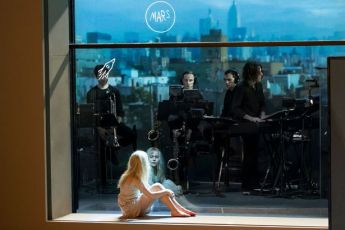 death – caught between two worlds like Newton. Then she asks Newton to
death – caught between two worlds like Newton. Then she asks Newton to
‘help me die properly’,
and Valentine hands him his knife, which Newton uses to kill her. But strangely, incredibly, it is the death of this Girl (or hope) that allows Newton to progress into something totally new; to give up
‘trying to turn these old words into something new’,
to totally embrace his
‘madness’,
and move into
‘that better place. An imagined world’:
the only place where the fluidity of the self and contentment with oneself can coexist peacefully.
The blood that seeps out from the body of the Girl isn’t red, it’s white – it looks like milk. It seems to suggest rebirth and newness – which is fulfilled as she wakes, announcing to Newton that she
‘found out my name’s Marley’;
an ambiguous line that could describe her identity before she ‘died’, or could be a new name. She is both a continuation of her old self and something completely new – she is fluid, undefinable. As she and Newton sing ‘Heroes’, and playfully belly-slide in the milk-blood ‘like dolphins can swim’, they are
‘…free now’
 both because of and despite the fact that they are
both because of and despite the fact that they are
‘…nothing
And nothing will help us’.
Yet that makes them free to create themselves however they would like to be. They can
‘travel on’
and become
‘lost in these stars’
without fear.
At least that’s how this viewer interpreted all of this – and I’m not sure that I’m right (or even on the right track). This is the main problem with Lazarus; it’s just too confusing. It’s like watching anything of Beckett as a musical: there isn’t really a plot and what is said is most often obscure. That said it would be unfair to say that this isn’t reflective of Bowie’s work – his songs often include bizarre and abstruse imagery (who on earth is the ‘Man Who Sold the World?’). Enda Walsh certainly has represented this in Lazarus – perhaps a little too much. Lazarus is really carried by the astonishing performances and reinvention of Bowie’s songs – in terms of both the stunning voices of those performing them, and Versweyveld’s setting for these songs. Still, there is something to say for the ambiguity (aside from the confusion) of Lazarus. It allows for a huge scope of interpretation – giving you plenty of room to relate what you see to your own state of affairs; especially in terms of being able to become comfortable with a fluid identity, or not quite knowing who you are at heart – or maybe that’s just me. Lazarus is abstruse at times; but losing yourself in its universe might point you towards new, self-realising, horizons.
___
More information about the production can be found at: https://www.lazarusmusical.com
___
by Emily Swettenham
20th November 2016
___
References:
[1] Bowie, D. 1992. ‘Bowie at the Bijou’. Interviewed by Campbell, V. for Movieline. In: David Bowie: The Last Interview and Other Conversations. 2016. [online]. Available at: https://books.google.co.uk/books?id=x_ClCwAAQBAJ&pg=PT100&lpg=PT100&dq=I+just+threw+my+real+self+into+that+movie+Bowie&source=bl&ots=D9J4iflmTg&sig=xVcY9Q3LAx2XF5ahRetz9jjfCc4&hl=en&sa=X&ved=0ahUKEwj00KP92bzQAhWECsAKHRVyDcQQ6AEIIjAC#v=onepage&q=I%20just%20threw%20my%20real%20self%20into%20that%20movie%20Bowie&f=false [Accessed: 20th November 2016].
[2] Ibid.
[3] Biblica. 2011. John 12:9.The Holy Bible, New International Version. [online]. Available at: https://www.biblegateway.com/passage/?search=John+12:9&version=NIV [Accessed: 20th November 2016].
[4] Maclean, R. 2016. ‘Bowie in Berlin: ‘He drove round the car park at 70mph screaming that he wanted to end it all’. The Guardian. [online]. Available at: https://www.theguardian.com/music/2016/jan/13/david-bowie-berlin-years-heroes-just-a-gigolo [Accessed: 20th November 2016].
[5] Ibid.
[6] Ibid.
[7] The Victoria and Albert Museum. 2013. ‘Touring Exhibition – David Bowie Is’. Available at: http://www.vam.ac.uk/content/exhibitions/david-bowie-is/ [Accessed: 20th November 2016].
[8] Marsh G. In: Beesely, R. 2013. ‘What is David Bowie’. Aesthetica. [online]. Available at: http://www.aestheticamagazine.com/what-is-david-bowie/ [Accessed: 20th November 2016].
